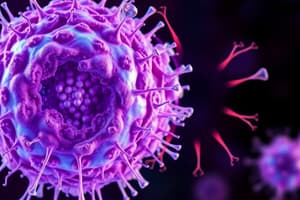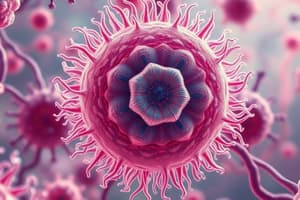Podcast
Questions and Answers
Which of the following is a characteristic unique to eukaryotic cells?
Which of the following is a characteristic unique to eukaryotic cells?
- The presence of a plasma membrane
- The presence of genetic material (DNA)
- The presence of a nucleus (correct)
- The presence of cytoplasm
The primary function of the smooth endoplasmic reticulum (SER) is protein synthesis.
The primary function of the smooth endoplasmic reticulum (SER) is protein synthesis.
False (B)
What is the main role of the Golgi apparatus in a cell?
What is the main role of the Golgi apparatus in a cell?
processing and packaging proteins and lipids
__________ are organelles containing digestive enzymes that break down cellular waste and debris.
__________ are organelles containing digestive enzymes that break down cellular waste and debris.
Match the following cytoskeletal fibers with their primary functions:
Match the following cytoskeletal fibers with their primary functions:
Which of the following cell signaling types involves communication over long distances using hormones?
Which of the following cell signaling types involves communication over long distances using hormones?
Mitosis results in four genetically distinct daughter cells.
Mitosis results in four genetically distinct daughter cells.
Define cell differentiation.
Define cell differentiation.
___________ is the primary energy currency of the cell.
___________ is the primary energy currency of the cell.
Match the following metabolic pathways with their descriptions:
Match the following metabolic pathways with their descriptions:
What is the main difference between apoptosis and necrosis?
What is the main difference between apoptosis and necrosis?
Cell adhesion molecules (CAMs) are only involved in cell-cell interactions and not cell-matrix interactions.
Cell adhesion molecules (CAMs) are only involved in cell-cell interactions and not cell-matrix interactions.
What are the main components of the extracellular matrix (ECM)?
What are the main components of the extracellular matrix (ECM)?
__________ transport does not require energy and includes diffusion, osmosis, and facilitated diffusion.
__________ transport does not require energy and includes diffusion, osmosis, and facilitated diffusion.
Match the following transport mechanisms with their descriptions:
Match the following transport mechanisms with their descriptions:
Which of the following organelles contains its own DNA and ribosomes, supporting the endosymbiotic theory?
Which of the following organelles contains its own DNA and ribosomes, supporting the endosymbiotic theory?
The cell cycle consists only of the mitotic (M) phase.
The cell cycle consists only of the mitotic (M) phase.
What is the role of cell cycle checkpoints?
What is the role of cell cycle checkpoints?
During meiosis, homologous chromosomes exchange genetic material through __________, increasing genetic diversity.
During meiosis, homologous chromosomes exchange genetic material through __________, increasing genetic diversity.
Match the following stem cell types with their differentiation potential:
Match the following stem cell types with their differentiation potential:
Flashcards
Cell Biology
Cell Biology
Study of cells, including their structure, function, and behavior.
Prokaryotic Cells
Prokaryotic Cells
Cells lacking a nucleus and other membrane-bound organelles.
Eukaryotic Cells
Eukaryotic Cells
Cells possessing a nucleus and other membrane-bound organelles.
Plasma Membrane
Plasma Membrane
Signup and view all the flashcards
Cytoplasm
Cytoplasm
Signup and view all the flashcards
Nucleus
Nucleus
Signup and view all the flashcards
Endoplasmic Reticulum (ER)
Endoplasmic Reticulum (ER)
Signup and view all the flashcards
Golgi Apparatus
Golgi Apparatus
Signup and view all the flashcards
Lysosomes
Lysosomes
Signup and view all the flashcards
Mitochondria
Mitochondria
Signup and view all the flashcards
Chloroplasts
Chloroplasts
Signup and view all the flashcards
Cytoskeleton
Cytoskeleton
Signup and view all the flashcards
Cell Cycle
Cell Cycle
Signup and view all the flashcards
Cell Division
Cell Division
Signup and view all the flashcards
Cell Differentiation
Cell Differentiation
Signup and view all the flashcards
Cell Metabolism
Cell Metabolism
Signup and view all the flashcards
Apoptosis
Apoptosis
Signup and view all the flashcards
Cell Adhesion
Cell Adhesion
Signup and view all the flashcards
Extracellular Matrix (ECM)
Extracellular Matrix (ECM)
Signup and view all the flashcards
Cell Transport
Cell Transport
Signup and view all the flashcards
Study Notes
- Cell biology involves studying their structure, function, and behavior.
- It includes cells physiological properties, interactions with the environment, and lifecycle.
- Understanding cell biology is fundamental to understanding tissues, organs, and entire organisms.
Cell Structure
- Cells are broadly classified into prokaryotic and eukaryotic cells based on their structure.
- Prokaryotic cells lack a nucleus and other membrane-bound organelles; Bacteria and Archaea are prokaryotes.
- Eukaryotic cells possess a nucleus and other membrane-bound organelles like mitochondria and endoplasmic reticulum; Eukaryotes include protists, fungi, plants, and animals.
- Key components of a cell include the plasma membrane, cytoplasm, and genetic material (DNA).
Plasma Membrane
- The plasma membrane is a selectively permeable barrier separating the cell's internal environment from the external environment.
- It comprises a lipid bilayer, mainly phospholipids, with embedded proteins and carbohydrates.
- The fluid mosaic model describes it as a dynamic structure where lipids and proteins can move laterally.
- Membrane proteins can function as transporters, receptors, enzymes, or anchors.
- Cholesterol within the membrane helps maintain fluidity and stability.
Cytoplasm
- The cytoplasm is the gel-like substance within the cell, excluding the nucleus.
- It contains various organelles, the cytoskeleton, and cytosol.
- Cytosol is the aqueous component of the cytoplasm, containing ions, small molecules, and macromolecules.
Nucleus
- The nucleus is the control center of the cell, housing genetic material (DNA) organized into chromosomes.
- It is surrounded by a double membrane called the nuclear envelope, containing nuclear pores for transport.
- The nucleolus within the nucleus is the site of ribosome synthesis.
- Chromatin, a complex of DNA and proteins, forms the chromosomes.
Endoplasmic Reticulum (ER)
- The endoplasmic reticulum is an extensive network of membranes involved in protein and lipid synthesis.
- There are two types of ER: rough ER (RER) and smooth ER (SER).
- RER is studded with ribosomes and is involved in protein synthesis and modification.
- SER lacks ribosomes and is involved in lipid synthesis, detoxification, and calcium storage.
Golgi Apparatus
- The Golgi apparatus processes and packages proteins and lipids synthesized in the ER.
- It consists of flattened membranous sacs called cisternae.
- Proteins and lipids are modified, sorted, and packaged into vesicles for transport to other organelles or the plasma membrane.
Lysosomes
- Lysosomes are organelles containing digestive enzymes that break down cellular waste and debris.
- They are involved in autophagy (self-eating) and phagocytosis (cellular eating).
- Lysosomes maintain an acidic internal environment to facilitate enzyme activity.
Mitochondria
- Mitochondria are the powerhouses of the cell, responsible for generating ATP through cellular respiration.
- They have a double membrane structure: an outer membrane and an inner membrane folded into cristae.
- The inner membrane contains the enzymes of the electron transport chain.
- Mitochondria contain their own DNA and ribosomes, suggesting an endosymbiotic origin.
Chloroplasts
- Chloroplasts are organelles found in plant cells and algae, responsible for photosynthesis.
- They contain chlorophyll, a pigment that captures light energy.
- Like mitochondria, chloroplasts have a double membrane and their own DNA and ribosomes.
- Photosynthesis converts light energy into chemical energy in the form of glucose.
Cytoskeleton
- The cytoskeleton is a network of protein fibers that provides structural support, facilitates cell movement, and enables intracellular transport.
- There are three main types of cytoskeletal fibers: microfilaments, intermediate filaments, and microtubules.
- Microfilaments (actin filaments) are involved in cell shape, muscle contraction, and cell motility.
- Intermediate filaments provide structural support and mechanical strength.
- Microtubules are involved in cell division, intracellular transport, and the structure of cilia and flagella.
Cell Communication
- Cells communicate with each other through various signaling molecules and receptors.
- Types of cell signaling include direct contact, paracrine signaling, endocrine signaling, and synaptic signaling.
- Receptors can be located on the cell surface or inside the cell.
- Signal transduction pathways convert extracellular signals into intracellular responses.
- Common signaling pathways involve protein kinases, second messengers, and transcription factors.
Cell Cycle
- The cell cycle is the series of events that a cell undergoes from one division to the next.
- It consists of interphase (G1, S, G2) and the mitotic (M) phase.
- During interphase, the cell grows, replicates its DNA, and prepares for division.
- The M phase involves mitosis (nuclear division) and cytokinesis (cytoplasmic division).
- Mitosis is divided into phases: prophase, metaphase, anaphase, and telophase.
- Cell cycle checkpoints ensure that each stage is completed accurately before proceeding to the next.
Cell Division
- Cell division is the process by which a cell divides into two or more daughter cells.
- Mitosis produces two genetically identical daughter cells and is used for growth and repair.
- Meiosis produces four genetically distinct daughter cells with half the number of chromosomes and is used for sexual reproduction.
- During meiosis, homologous chromosomes exchange genetic material through crossing over, increasing genetic diversity.
Cell Differentiation
- Cell differentiation is the process by which cells become specialized in structure and function.
- During development, cells receive signals that activate specific genes, leading to differentiation.
- Differentiated cells have distinct patterns of gene expression.
- Stem cells are undifferentiated cells that can divide and differentiate into various cell types.
- Totipotent stem cells can differentiate into any cell type, including embryonic tissues.
- Pluripotent stem cells can differentiate into any cell type in the body, but not embryonic tissues.
Cell Metabolism
- Cell metabolism encompasses all the chemical reactions that occur within a cell to sustain life.
- These reactions include catabolism (breaking down molecules) and anabolism (building up molecules).
- Enzymes catalyze metabolic reactions.
- ATP (adenosine triphosphate) is the primary energy currency of the cell.
- Key metabolic pathways include glycolysis, the Krebs cycle (citric acid cycle), and oxidative phosphorylation.
Cell Death
- Cell death is a normal and essential process in multicellular organisms.
- Apoptosis is programmed cell death, which is characterized by controlled self-destruction.
- Necrosis is uncontrolled cell death, often caused by injury or infection, leading to inflammation.
- Apoptosis plays a crucial role in development, tissue homeostasis, and immune function.
Cell Adhesion
- Cell adhesion is the process by which cells bind to each other and to the extracellular matrix.
- Cell adhesion molecules (CAMs) mediate cell-cell and cell-matrix interactions.
- Types of CAMs include cadherins, integrins, selectins, and immunoglobulin superfamily members.
- Cell adhesion is important for tissue structure, cell migration, and cell signaling.
Extracellular Matrix (ECM)
- The extracellular matrix is a network of proteins and polysaccharides secreted by cells.
- It provides structural support, regulates cell behavior, and mediates cell-cell communication.
- Major components of the ECM include collagen, elastin, fibronectin, and proteoglycans.
- The ECM influences cell adhesion, migration, differentiation, and proliferation.
Cell Transport
- Cell transport mechanisms facilitate the movement of molecules across the plasma membrane.
- Passive transport does not require energy and includes diffusion, osmosis, and facilitated diffusion.
- Active transport requires energy and includes primary active transport and secondary active transport.
- Vesicular transport involves the movement of large molecules or particles within vesicles, including endocytosis and exocytosis.
Studying That Suits You
Use AI to generate personalized quizzes and flashcards to suit your learning preferences.




